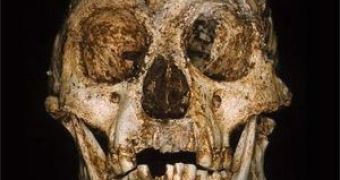The small 18,000-year-old human skull discovered in Flores Island, Indonesia, in 2003, provoked quite a stir. Many people came up with hypotheses of a new hominid species, Homo floresiensis, that evolved locally from Homo erectus and co-existed with modern humans, Homo sapiens.
Others suggested that the skull could have belonged to a person suffering from a genetic condition known as microcephaly ("small head").
The researchers realized that the brain of the Flores skull (at 400 cc, less than one-third of the normal size for a modern human of about 1600 cc) is simply too small to fit anything previously known about human brain evolution. The remains of 8 individuals were unearthed, but the brain size of only one is known. All the individuals were small-bodied, so they might have belonged to a pygmy population, but there were no further studies about this issue.
In fact, even today, in Flores survive remnants of an archaic population of the island, the Rampasasa pygmies, probably the original population before the Malayic-speaking populations entered the island. The pygmies are an ancient race, related to the Asian Negroid race (like Papuans, Melanesians, Australian Aborigines, groups from South India), and groups of pygmies are found in Philippines, Malacca, New Guinea and Equatorial Africa, even today.
Another area of controversy concerns the stone tools discovered in association with the Flores fossils. This kind of sophisticated stone tools associated with the fossil from Flores had only been reported for our own species, Homo sapiens. Some have claimed continuity with tools from Mata Menge on Flores that are purportedly 800,000 years old, which is simply implausible.
Microcephaly can be caused by over 400 different mutant genes and a wide range of corresponding syndromes. Most syndromes involve pronounced deficits ("low-functioning microcephaly") and the affected individuals die early, but some have mild effects ("high-functioning microcephaly"), permitting survival into adulthood and a surprising degree of behavioral competence in certain cases. Microcephaly is often associated with a small body, but not always. The skeleton with microcephaly from Flores was of an adult, so it must be assigned to a "high-functioning" microcephalic. Comparisons with skulls and brain casts of modern "high functioning" microcephalics showed a match. The large teeth ("megadonty") in fossils are in fact normally associated with microcephaly.
A new study, published in the journal "Proceedings of the Royal Society B: Biological Sciences," shows that the "hobbits" could have been severely malnourished Homo sapiens, affected by a condition of the thyroid gland called cretinism, connected to dwarfing and mental retardation. Cretinism is provoked by a lack of iodine in the diet.
"Very quickly I found there were some quite surprising similarities between the dwarf cretins and these little people of Flores," said lead researcher Peter Obendorf of RMIT University in Melbourne, Australia.
The fossils present a similar type of arrested bone growth connected to shorter and thicker bones, a twisting of the arm bone, and some traits in the wrist (like the trapezoid bone separated into pieces) and skull similar to cretinism (even if the pituitary gland is not enlarged like in most cretinism cases).
But some ideas are hard to change.
"The bone lines up too well with other wrist bones to be missing a piece. It resembles those of chimpanzees and gorillas," said Matthew Tocheri, an anthropologist at the Smithsonian Institution in Washington, D.C., who published studies in the favor of the hypothesis of the new species.
But this has been weak from the beginning.
"For one, small-bodied modern humans were on the nearby island of Timor at least 42,000 years ago and made stone tools similar to those associated with the hobbits. More detailed studies of features such as wrist and teeth bones support the suggestion the hobbit was a diseased modern human. From his perspective, that disease was cretinism. A malnourished 30-year-old cretin would become burdensome to a hunter-gatherer society on Flores. At some stage they would either be left in some suitable environment or just become estranged and find themselves left alone dying in a cave," he said.
Anyway, it is hard to imagine how a dwarf more primitive species could have co-existed for over 20,000 years with much more technologically advanced modern humans. Cretinism or microcephaly, any of these seems more logical.

 14 DAY TRIAL //
14 DAY TRIAL //